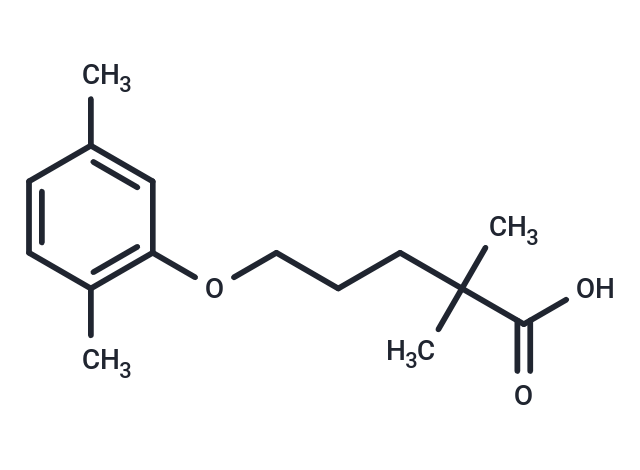- Remove All
 Your shopping cart is currently empty
Your shopping cart is currently empty
Gemfibrozil
Gemfibrozil (CI-719) interacts with peroxisome proliferator-activated receptors (PPARalpha) resulting in PPARalpha-mediated stimulation of fatty acid oxidation and an increase in lipoprotein lipase (LPL) synthesis. Gemfibrozil is a fibric acid derivative with hypolipidemic effects. This enhances triglyceride-rich lipoprotein clearance and reduces the expression of apolipoprotein C-III (apoC-III). The reduction in hepatic production of apoC-III result in the subsequent reduction of serum levels of very-low-density-lipoprotein cholesterol (VLDL-C). In addition, gemfibrozil-mediated PPARalpha stimulation of apoA-I and apoA-II expression results in an increase in high-density lipoprotein cholesterol (HDL-C).

Gemfibrozil
| Pack Size | Price | Availability | Quantity |
|---|---|---|---|
| 25 mg | 28 € | In Stock | |
| 50 mg | 36 € | In Stock | |
| 100 mg | 47 € | In Stock | |
| 200 mg | 59 € | In Stock | |
| 1 mL x 10 mM (in DMSO) | 47 € | In Stock |
Product Introduction
| Description | Gemfibrozil (CI-719) interacts with peroxisome proliferator-activated receptors (PPARalpha) resulting in PPARalpha-mediated stimulation of fatty acid oxidation and an increase in lipoprotein lipase (LPL) synthesis. Gemfibrozil is a fibric acid derivative with hypolipidemic effects. This enhances triglyceride-rich lipoprotein clearance and reduces the expression of apolipoprotein C-III (apoC-III). The reduction in hepatic production of apoC-III result in the subsequent reduction of serum levels of very-low-density-lipoprotein cholesterol (VLDL-C). In addition, gemfibrozil-mediated PPARalpha stimulation of apoA-I and apoA-II expression results in an increase in high-density lipoprotein cholesterol (HDL-C). |
| Targets&IC50 | CYP2C9:5.8 μM(Ki), 2C19:24 μM(Ki), 1A2:82 μM(Ki), 2C8:69 μM(Ki) |
| In vitro | Gemfibrozil exerts a minimal inhibitory effect on CYP3A-mediated simvastatin hydroxy acid (SVA) oxidation, but does inhibit SVA glucuronidation in dog and human liver microsomes. [1] Gemfibrozil markedly inhibits M-23 formation, with a K(i) (IC(50)) value of 69 (95) mM, whereas inhibition of M-1 formation is weaker with a K(i) (IC(50)) value of 273 mM in human liver microsomes. [2] Gemfibrozil strongly and competitively inhibits CYP2C9 activity, with a K(i) (IC(50)) value of 5.8 (9.6) mM. Gemfibrozil exhibits somewhat smaller inhibitory effects on CYP2C19 and CYP1A2 activities, with K(i) (IC(50)) values of 24 (47) mM and 82 (136) mM, respectively. [3] Gemfibrozil, a lipid-lowering drug, inhibits cytokine-induced production of NO and the expression of inducible nitric-oxide synthase (iNOS) in human U373 mg astroglial cells and primary astrocytes. Gemfibrozil induces peroxisome proliferator-responsive element (PPRE)-dependent luciferase activity, which is inhibited by the expression of DeltahPPAR-alpha, the dominant-negative mutant of human PPAR-alpha. Gemfibrozil strongly inhibits the activation of NF-kappaB, AP-1, and C/EBPbeta but not that of gamma-activation site (GAS) in cytokine-stimulated astroglial cells. [4] |
| In vivo | Gemfibrozil treatment significantly reduces (2-3-fold) the plasma clearance of SVA and the biliary excretion of SVA glucuronide (together with its cyclization product SV), but not the excretion of a major oxidative metabolite of SVA in dogs. [1] |
| Alias | Lopid, Jezil, Decrelip, CI-719 |
| Molecular Weight | 250.33 |
| Formula | C15H22O3 |
| Cas No. | 25812-30-0 |
| Smiles | CC1=CC(OCCCC(C)(C)C(O)=O)=C(C)C=C1 |
| Relative Density. | 1.044 |
| Storage | Powder: -20°C for 3 years | In solvent: -80°C for 1 year | Shipping with blue ice. | |||||||||||||||||||||||||||||||||||
| Solubility Information | DMSO: 50 mg/mL (199.74 mM) Ethanol: 47 mg/mL (187.8 mM) | |||||||||||||||||||||||||||||||||||
Solution Preparation Table | ||||||||||||||||||||||||||||||||||||
Ethanol/DMSO
| ||||||||||||||||||||||||||||||||||||
Calculator
In Vivo Formulation Calculator (Clear solution)
Dose Conversion
Tech Support
Keywords

Copyright © 2015-2024 TargetMol Chemicals Inc. All Rights Reserved.



